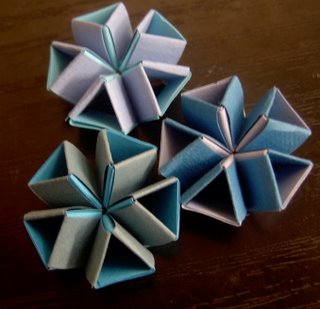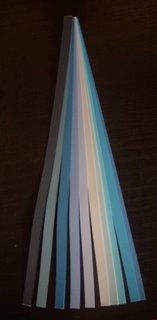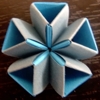bright starts
Fiver keeps a collection of origami dodecahedra that I've made over the years on his desk at work. Tomorrow he's going back to the same workplace, but will be sitting at a new desk, doing a new job. So I thought I would send him off to his new beginnings with a new dodecahedron, and here are the results of my day's work.
 A dodecahedron is a polyhedron with 12 faces, 30 edges, and 20 points or vertices. This dodecahedron is composed of 150 little strips of paper, using a construction technique by Heinz Strobl (called Snapology), diagrammed here. Although I suppose Snapology is considered a form of modular origami, the technique involves simple paper manipulation, and very little actual folding.
A dodecahedron is a polyhedron with 12 faces, 30 edges, and 20 points or vertices. This dodecahedron is composed of 150 little strips of paper, using a construction technique by Heinz Strobl (called Snapology), diagrammed here. Although I suppose Snapology is considered a form of modular origami, the technique involves simple paper manipulation, and very little actual folding. The diagrammed instructions for the Snapology method show how to built an icosahedron (a polyhedron consisting of 20 faces, usually all equilateral triangles). I took five of these individual equilateral triangles and made up twelve individual units or groups (shown above, consisting of 10 strips of paper each - 5 making up the triangles, and 5 'snapping' together the triangles), and then joined them up to form a dodecahedron, where each of the 12 faces is composed of 5 equilateral triangles. I suppose many others have used Snapology in exactly this same way before, but I haven't been able to find any photos of a Snapology dodecahedron yet on the web, so I thought I'd post these with a few details. (Incidentally, the icosahedron and dodecahedron are related geometrically in ways which are completely mysterious to me.)
The diagrammed instructions for the Snapology method show how to built an icosahedron (a polyhedron consisting of 20 faces, usually all equilateral triangles). I took five of these individual equilateral triangles and made up twelve individual units or groups (shown above, consisting of 10 strips of paper each - 5 making up the triangles, and 5 'snapping' together the triangles), and then joined them up to form a dodecahedron, where each of the 12 faces is composed of 5 equilateral triangles. I suppose many others have used Snapology in exactly this same way before, but I haven't been able to find any photos of a Snapology dodecahedron yet on the web, so I thought I'd post these with a few details. (Incidentally, the icosahedron and dodecahedron are related geometrically in ways which are completely mysterious to me.) As a mathematical 'proof', I made all 30 of the edges in white, so the pentagonal faces and the vertices where three pentagons meet can be easily picked out against the pattern and texture of the thing as a whole. I have failed to include anything for scale, but the size of this is about the same as a large plum, or a squash ball. The Snapology results in an incredibly strong structure; there is no glue used in this at all, and it is sturdy enough to toss around, drop on the floor, and squeeze (albeit gently).
As a mathematical 'proof', I made all 30 of the edges in white, so the pentagonal faces and the vertices where three pentagons meet can be easily picked out against the pattern and texture of the thing as a whole. I have failed to include anything for scale, but the size of this is about the same as a large plum, or a squash ball. The Snapology results in an incredibly strong structure; there is no glue used in this at all, and it is sturdy enough to toss around, drop on the floor, and squeeze (albeit gently). Although most origami begins with a square, and indeed, Snapology can easily be done with strips of paper cut from any shape or size of paper, I took a little shortcut and used paper which is marketed for quilling - this meant I didn't have to fiddle about with cutting little strips of paper before even getting started. (It also meant that I got to use up some stash. yes I have more paper stashed than yarn.) The strips of paper used for the Han Ji stars (found frequently in paper shops and the like) would also work just fine, but might be a bit narrow and fiddly unless you are very dextrous!
Although most origami begins with a square, and indeed, Snapology can easily be done with strips of paper cut from any shape or size of paper, I took a little shortcut and used paper which is marketed for quilling - this meant I didn't have to fiddle about with cutting little strips of paper before even getting started. (It also meant that I got to use up some stash. yes I have more paper stashed than yarn.) The strips of paper used for the Han Ji stars (found frequently in paper shops and the like) would also work just fine, but might be a bit narrow and fiddly unless you are very dextrous! Others have done some truly amazing things with Snapology. It's a method that's worth exploring more. If you give it a try, let me know - I would love to see what you come up with!
Others have done some truly amazing things with Snapology. It's a method that's worth exploring more. If you give it a try, let me know - I would love to see what you come up with!



<< Home